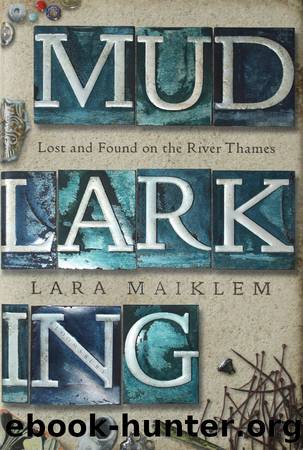Mudlarking_Lost and Found on the River Thames by Lara Maiklem

Author:Lara Maiklem [Maiklem, Lara]
Language: eng
Format: epub
ISBN: 9781408889237
Google: sPQRyAEACAAJ
Publisher: Bloomsbury Publishing Plc
Published: 2020-03-05T18:39:05+00:00
TOWER BEACH
Education she has none, and she never had instruction worthy the name. All her knowledge is to know the time of low water, and the value of the wrecks and waifs which each recurring tide scatters all too scantily over her peculiar domain.
Charles Manby Smith, âThe Tide Waitressâ, Curiosities of London Life or Phases, Physiological and Social of the Great Metropolis (1853)
Some people refer to the foreshore in front of the Tower of London as a beach and it certainly looks like one. But itâs not easy to get to. It is the stretch of foreshore on the north side of the river just to the west of Tower Bridge that runs the entire length of the Tower complex. I walked to it once, a number of years ago, along the foreshore from Custom House, a little further west where there are easy river stairs. I wasnât planning to mudlark, I just wanted to have a look. That was on a particularly low tide and involved a lot of clambering over slimy wooden posts and wading through deep mud under jetties and piers, which I donât like doing if I can avoid it. I recall collecting quite a bit of small change as I scrambled through the muddy obstacle course, emerging onto a wide stretch of completely empty yellow sand just beyond it.
I carried on towards Tower Bridge, past a wide stone staircase set into the river wall called Queenâs Stairs, which were last used by a queen, Queen Mary, in 1938. They would have been the easiest and safest way down onto the beach, but these days they are kept locked. Thereâs a tall gate halfway down thatâs crowned by a row of spiked railings, which makes it impossible for anyone to scale. Lack of use has turned the lower steps, where the river covers them at high tide, dark emerald green with algae.
From the foreshore you can see a wide bricked-in arch in the river wall with the words âENTRY TO THE TRAITORâS GATEâ stencilled above it in large white capital letters. The river entrance was bricked up in the middle of the nineteenth century and Traitorâs Gate itself is on the other side of the wall. It was originally known as the Water Gate and was built in the late thirteenth century on the orders of Edward I to provide a convenient means to reach the Tower by barge. It acquired its present name in the sixteenth century, as the Tower evolved into a place of imprisonment, torture and beheading. Most famously, two of Henry VIIIâs wives, Anne Boleyn and Catherine Howard, came this way by barge before meeting their fate at the Tower. Anneâs daughter, the future Elizabeth I, was luckier. She arrived at the Tower on Palm Sunday 1554, sick with fever, on the order of her half-sister, Queen Mary, who had accused her of plotting against her. Her barge had already shot the rapids under London Bridge on a low tide, which everyone
Download
This site does not store any files on its server. We only index and link to content provided by other sites. Please contact the content providers to delete copyright contents if any and email us, we'll remove relevant links or contents immediately.
| Anthropology | Archaeology |
| Philosophy | Politics & Government |
| Social Sciences | Sociology |
| Women's Studies |
Mysteries by Colin Wilson(3251)
People of the Earth: An Introduction to World Prehistory by Dr. Brian Fagan & Nadia Durrani(2619)
Ancient Worlds by Michael Scott(2493)
Foreign Devils on the Silk Road: The Search for the Lost Treasures of Central Asia by Peter Hopkirk(2388)
The Memory Code by Lynne Kelly(2273)
The Splendid and the Vile by Erik Larson(2228)
Lost Technologies of Ancient Egypt by Christopher Dunn(2111)
The Earth Chronicles Handbook by Zecharia Sitchin(2101)
Come, Tell Me How You Live by Mallowan Agatha Christie(2028)
The Plantagenets by Dan Jones(1933)
Last Chance to See by Douglas Adams(1850)
The Return of the Gods by Erich von Daniken(1839)
Wars of the Anunnaki by Chris H. Hardy(1632)
Keeper of Genesis by Graham Hancock(1542)
Before the Dawn by Nicholas Wade(1532)
The Cygnus Mystery by Andrew Collins(1470)
The Message of the Sphinx by Graham Hancock(1433)
Fragile Lives by Stephen Westaby(1364)
Hieroglyphs: A Very Short Introduction by Penelope Wilson(1271)
